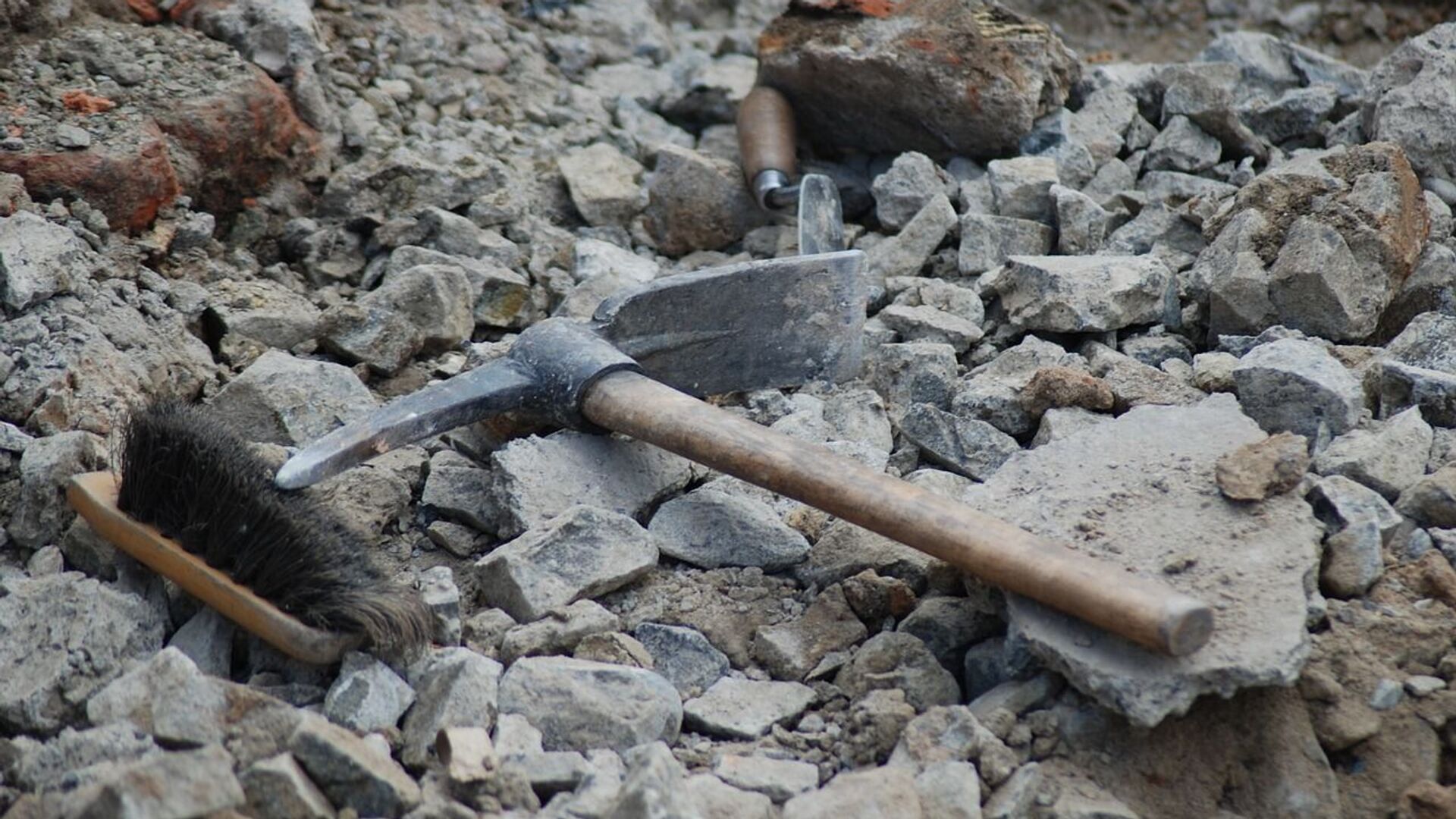https://sputnikglobe.com/20220512/discovery-of-iron-age-artwork-found-beneath-house-in-southeastern-turkey-1095448572.html
Discovery of Iron Age Artwork Found Beneath House in Southeastern Turkey
Discovery of Iron Age Artwork Found Beneath House in Southeastern Turkey
Sputnik International
Found on a rock wall of a subterranean complex in Turkey is a panel from the Middle Iron Age of the early first millennium BCE. The artwork is the first known... 12.05.2022, Sputnik International
2022-05-12T02:39+0000
2022-05-12T02:39+0000
2022-10-19T20:18+0000
history
turkiye
archaeology
https://cdn1.img.sputnikglobe.com/img/07e4/07/10/1079904806_0:110:1281:830_1920x0_80_0_0_0ca9a68ea14540d5b4fc17a3cb682cbb.jpg
The journal Antiquity published an article Tuesday in which a team of archaeologists revealed a rare discovery beneath a home in southeastern Turkey - an age-old rock carving.The 3,000 year-old rock carving was first discovered in 2017 by looters who had broken into the subterranean complex made up of hundreds of feet of passages, staircases, and galleries chiseled out of bedrock. The complex was found 30 miles away from the entrance of its secret passage —which was created by looters— beneath a modern two-story home in the village of Başbük.After the looters were caught by police, they turned the discovery over to a team of archaeologists.According to researchers, the 12-foot-wide carving is a Başbük procession scene beginning with the leading male deity Hadad, the Mesopotamian god of storms who is often depicted with his triple lightning fork.Hadad is accompanied by what the researchers believe is a Ištar-type goddess consort who wears a double-horned, cylindrical crown with a set star. Other deities etched into the panel include Sîn, the moon god, and the sun god Šamaš. Researchers remain uncertain about the identity of the other four gods or deities, though they believe one is male and the other two are female.Lead study author Mehmet Önal first set eyes on the archeological discovery, assisted only by the dim flickering light of a lamp.Researchers believe construction of the carvings as well as the construction of the subterranean complex unexpectedly stopped in the early 8th century BCE. The archeologists found an inscription beside the carving they think states “Mukīn-abūa,” a governor of the capital of Tušhan whose name is listed in Assyrian records from 2,700 years ago. Tušhan is roughly 90 miles to the east of what is now known as modern Başbük.Article co-author and philologist Selim Ferruh Adali of the Social Sciences University of Ankara notes that although the deities are Assyrian, with their rigid poses and the intricate, curling style of their hair and beards, other details of the carving such as the inscriptions and the names of the gods are written in Aramaic. “It’s primarily Aramaic symbolism that we find, melded with Assyrian style,” says Adali.“The inscriptions in Aramaic emphasize the intention to have a dialogue with local communities, [while] the use of Assyrian figurative style shows the need to interact with the Assyrian political power,” adds archaeologist Davide Nadali of Rome’s Sapienza University.The artwork reveals how two cultures, the Assyrians and the Arameans, may have been able to integrate their cultures despite Neo-Assyrian control over the region, says Adali.
turkiye
Sputnik International
feedback@sputniknews.com
+74956456601
MIA „Rosiya Segodnya“
2022
Mary Manley
https://cdn1.img.sputnikglobe.com/img/07e6/01/0b/1092187887_0:0:2048:2049_100x100_80_0_0_0c2cc4c84f89aff034cc55bb01fb6697.jpg
Mary Manley
https://cdn1.img.sputnikglobe.com/img/07e6/01/0b/1092187887_0:0:2048:2049_100x100_80_0_0_0c2cc4c84f89aff034cc55bb01fb6697.jpg
News
en_EN
Sputnik International
feedback@sputniknews.com
+74956456601
MIA „Rosiya Segodnya“
Sputnik International
feedback@sputniknews.com
+74956456601
MIA „Rosiya Segodnya“
Mary Manley
https://cdn1.img.sputnikglobe.com/img/07e6/01/0b/1092187887_0:0:2048:2049_100x100_80_0_0_0c2cc4c84f89aff034cc55bb01fb6697.jpg
history, turkiye, archaeology
history, turkiye, archaeology
Discovery of Iron Age Artwork Found Beneath House in Southeastern Turkey
02:39 GMT 12.05.2022 (Updated: 20:18 GMT 19.10.2022) Found on a rock wall of a subterranean complex in Turkey is a panel from the Middle Iron Age of the early first millennium BCE. The artwork is the first known example of a Neo-Assyrian-period rock relief with Aramaic inscriptions and reveals how two civilizations were able to integrate through shared culture.
The journal
Antiquity published an article Tuesday in which a team of archaeologists revealed a rare discovery beneath a home in southeastern Turkey - an age-old rock carving.
The 3,000 year-old rock carving was first discovered in 2017 by looters who had broken into the subterranean complex made up of hundreds of feet of passages, staircases, and galleries chiseled out of bedrock. The complex was found 30 miles away from the entrance of its secret passage —which was created by looters— beneath a modern two-story home in the village of Başbük.
After the looters were caught by police, they turned the discovery over to a team of archaeologists.
According to researchers, the 12-foot-wide carving is a Başbük procession scene beginning with the leading male deity Hadad, the Mesopotamian god of storms who is often depicted with his triple lightning fork.
Hadad is accompanied by what the researchers believe is a Ištar-type goddess consort who wears a double-horned, cylindrical crown with a set star. Other deities etched into the panel include Sîn, the moon god, and the sun god Šamaš. Researchers remain uncertain about the identity of the other four gods or deities, though they believe one is male and the other two are female.
Lead study author Mehmet Önal first set eyes on the archeological discovery, assisted only by the dim flickering light of a lamp.
“I felt as if I was in a ritual,” recalls Önal, who also serves as the head of archeology at Harran University in Şanlıurfa. “When I was confronted by the very expressive eyes and majestic, serious face of the storm god Hadad, I felt a slight tremor in my body.”
Researchers believe construction of the carvings as well as the construction of the subterranean complex unexpectedly stopped in the early 8th century BCE. The archeologists found an inscription beside the carving they think states “Mukīn-abūa,” a governor of the capital of Tušhan whose name is listed in Assyrian records from 2,700 years ago. Tušhan is roughly 90 miles to the east of what is now known as modern Başbük.
Article co-author and philologist Selim Ferruh Adali of the Social Sciences University of Ankara notes that although the deities are Assyrian, with their rigid poses and the intricate, curling style of their hair and beards, other details of the carving such as the inscriptions and the names of the gods are written in Aramaic. “It’s primarily Aramaic symbolism that we find, melded with Assyrian style,” says Adali.
“The inscriptions in Aramaic emphasize the intention to have a dialogue with local communities, [while] the use of Assyrian figurative style shows the need to interact with the Assyrian political power,” adds archaeologist Davide Nadali of Rome’s Sapienza University.
The artwork reveals how two cultures, the Assyrians and the Arameans, may have been able to integrate their cultures despite Neo-Assyrian control over the region, says Adali. 



